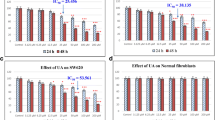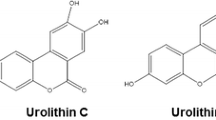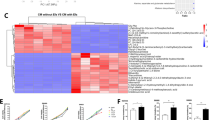Abstract
Purpose
Urolithins, metabolites produced by the gut microbiota from ellagic acid, have been acknowledged with cancer chemopreventive activity. Although urolithin A (Uro-A) has been reported to be the most active one, 10–50 % of humans can also produce the isomer isourolithin A (IsoUro-A). However, no biological activity for IsoUro-A has been reported so far. Herein, we describe for the first time the antiproliferative effect of IsoUro-A, compared to Uro-A, against both human colon cancer (Caco-2) and normal (CCD18-Co) cell lines.
Methods
Cell proliferation was evaluated by MTT and Trypan blue exclusion assays. Cell cycle was analyzed by flow cytometry and apoptosis measured by the Annexin V/PI method. Finally, urolithins metabolism was analyzed by HPLC–DAD-MS/MS.
Results
IsoUro-A inhibited the proliferation of Caco-2 cells in a time- and dose-dependent manner, though it was significantly lower than Uro-A (IC50 = 69.7 ± 4.5 and 49.2 ± 3.8 μM at 48 h, respectively). Both urolithins arrested Caco-2 cell cycle at S and G2/M phases and induced apoptosis at concentrations previously found in human colon tissues. Notably, Caco-2 cells glucuronidated more efficiently IsoUro-A than Uro-A (~50 vs. ~20 % of conversion after 48 h, respectively). Both Uro-A and IsoUro-A glucuronides did not exert antiproliferative effects. In addition, cell growth inhibition was higher in Caco-2 than in normal cells.
Conclusions
IsoUro-A exerts strong antiproliferative activity, which is reduced by the extensive glucuronidation at 9-position in cancer cells. Further studies are needed to elucidate whether the in vitro structure–activity relationship found for Uro-A and IsoUro-A plays any role in humans.







Similar content being viewed by others
Abbreviations
- ACN:
-
Acetonitrile
- ATCC:
-
American type culture collection
- CRC:
-
Colorectal cancer
- DMSO:
-
Dimethyl sulfoxide
- FBS:
-
Fetal bovine serum
- FITC:
-
Fluorescein isothiocyanate
- Glur:
-
Glucuronide
- HPLC:
-
High-performance liquid chromatography
- IC50 :
-
Half-maximal inhibitory concentration
- IsoUro:
-
Isourolithin
- MEM:
-
Minimal essential medium
- MeOH:
-
Methanol
- MS:
-
Mass spectrometry
- MTT:
-
3-(4,5-Dimethyl-2-thiazolyl)-2,5-diphenyl-2H-tetrazolium bromide
- OD:
-
Optical density
- PBS:
-
Phosphate-buffered saline
- PI:
-
Propidium iodide
- SD:
-
Standard deviation
- UGTs:
-
UDP-glucuronosyltransferases
- Uro:
-
Urolithins
- μM:
-
Micromolar
References
Cerdá B, Espín JC, Parra S, Martínez P, Tomás-Barberán FA (2004) The potent in vitro antioxidant ellagitannins from pomegranate juice are metabolised into bioavailable but poor antioxidant hydroxy-6H-dibenzopyran-6-one derivatives by the colonic microflora of healthy humans. Eur J Nutr 43:205–220
Cerdá B, Tomás-Barberán FA, Espín JC (2005) Metabolism of antioxidant and chemopreventive ellagitannins from strawberries, raspberries, walnuts, and oak-aged wine in humans: identification of biomarkers and individual variability. J Agric Food Chem 53:227–235
Seeram NP, Henning SM, Zhang Y, Suchard M, Li Z, Heber D (2006) Pomegranate juice ellagitannin metabolites are present in human plasma and some persist in urine for up to 48 hours. J Nutr 136:2481–2485
González-Sarrías A, Giménez-Bastida JA, García-Conesa MT, Gómez-Sánchez MB, García-Talavera NV, Gil-Izquierdo A, Sánchez-Alvarez C, Fontana-Compiano LO, Morga-Egea JP, Pastor-Quirante FA, Martínez-Síaz F, Tomás-Barberán FA, Espín JC (2010) Occurrence of urolithins, gut microbiota ellagic acid metabolites and proliferation markers expression response in the human prostate gland upon consumption of walnuts and pomegranate juice. Mol Nutr Food Res 54:311–322
Larrosa M, García-Conesa MT, Espín JC, Tomás-Barberán FA (2010) Ellagitannins, ellagic acid and vascular health. Mol Aspects Med 31:513–539
Espín JC, Larrosa M, García-Conesa MT, Tomás-Barberán FA (2013) Biological significance of urolithins, the gut microbial ellagic acid-derived metabolites: the evidence so far. Evid-Based Complement Alt 270418
González-Sarrías A, Espín JC, Tomás-Barberán FA, García-Conesa MT (2009) Gene expression, cell cycle arrest and MAPK signalling regulation in Caco-2 cells exposed to ellagic acid and its metabolites, urolithins. Mol Nutr Food Res 53:686–698
González-Sarrías A, Tomé-Carneiro J, Bellesia A, Tomás-Barberán FA, Espín JC (2015) The ellagic acid-derived gut microbiota metabolite, urolithin A, potentiates the anticancer effects of 5-fluorouracil chemotherapy on human colon cancer cells. Food Funct 6:1460–1469
Kasimsetty SG, Bialonska D, Reddy MK, Ma G, Khan SI, Ferreira D (2010) Colon cancer chemopreventive activities of pomegranate ellagitannins and urolithins. J Agric Food Chem 58:2180–2187
Cho H, Jung H, Lee H, Yi HC, Kwak HK, Hwang KT (2015) Chemopreventive activity of ellagitannins and their derivatives from black raspberry seeds on HT-29 colon cancer cells. Food Funct 6:1675–1683
González-Sarrías A, Giménez-Bastida JA, Núñez-Sánchez MA, Larrosa M, García-Conesa MT, Tomás-Barberán FA, Espín JC (2014) Phase-II metabolism limits the antiproliferative activity of urolithins in human colon cancer cells. Eur J Nutr 53:853–864
Tomás-Barberán FA, García-Villalba R, González-Sarrías A, Selma MV, Espín JC (2014) Ellagic acid metabolism by human gut microbiota: consistent observation of three urolithin phenotypes in intervention trials, independent of food source, age, and health status. J Agric Food Chem 62:6535–6538
Nuñez-Sánchez MA, García-Villalba R, Monedero-Saiz T, García-Talavera NV, Gómez-Sánchez MB, Sánchez-Álvarez C, García-Albert AM, Rodríguez-Gil FJ, Ruiz-Marín M, Pastor-Quirante FA, Martínez-Díaz F, Yáñez-Gascón MJ, González-Sarrías A, Tomás-Barberán FA, Espín JC (2014) Targeted metabolic profiling of pomegranate polyphenols and urolithins in plasma, urine and colon tissues from colorectal cancer patients. Mol Nutr Food Res 58:1199–1211
Romo-Vaquero M, García-Villalba R, González-Sarrías A, Beltrán D, Tomás-Barberán FA, Espín JC, Selma MV (2015) Interindividual variability in the human metabolism of ellagic acid: contribution of Gordonibacter to urolithin production. J Funct Foods 17:785–791
Giménez-Bastida JA, Larrosa M, González-Sarrías A, Tomás-Barberán F, Espín JC, García-Conesa MT (2012) Intestinal ellagitannin metabolites ameliorate cytokine-induced inflammation and associated molecular markers in human colon fibroblasts. J Agric Food Chem 60:8866–8876
González-Sarrías A, Miguel V, Merino G, Lucas R, Morales JC, Tomás-Barberán F, Alvarez AI, Espín JC (2013) The gut microbiota ellagic acid-derived metabolite urolithin A, and its sulfate conjugate, are substrates for the drug efflux transporter breast cancer resistance protein (ABCG2/BCRP). J Agric Food Chem 61:4352–4359
González-Barrio R, Truchado P, Ito H, Espín JC, Tomás-Barberán FA (2011) UV and MS identification of urolithins and nasutins, the bioavailable metabolites of ellagitannins and ellagic acid in different mammals. J Agric Food Chem 59:1152–1162
García-Villalba R, Beltrán D, Espín JC, Selma MV, Tomás-Barberán FA (2013) Time course production of urolithins from ellagic acid by human gut microbiota. J Agric Food Chem 61:8797–8806
Piwowarski JP, Granica S, Kiss AK (2014) Influence of gut microbiota-derived ellagitannins’ metabolites urolithins on pro-inflammatory activities of human neutrophils. Planta Med 80:887–895
Ramírez de Molina A, Vargas T, Molina S, Sánchez J, Martínez-Romero J, González-Vallinas M, Martín-Hernández R, Sánchez-Martínez R, Gómez de Cedrón M, Dávalos A, Calani L, Del Rio D, González-Sarrías A, Espín JC, Tomás-Barberán FA, Reglero G (2015) The ellagic acid derivative 4,4′-di-O-methylellagic acid efficiently inhibits colon cancer cell growth through a mechanism involving WNT16. J Pharmacol Exp Ther 353:433–444
Riddick DS, Lee C, Ramji S, Chinje EC, Cowen RL, Williams KJ, Patterson AV, Stratford IJ, Morrow CS, Townsend AJ, Jounaidi Y, Chen CS, Su T, Lu H, Schwartz PS, Waxman DJ (2005) Cancer chemotherapy and drug metabolism. Drug Metab Dispos 33:1083–1096
Zhang L, Zuo Z, Lin G (2007) Intestinal and hepatic glucuronidation of flavonoids. Mol Pharm 4:833–845
Shen SC, Chen YC, Hsu FL, Lee WR (2003) Differential apoptosis-inducing effect of quercetin and its glycosides in human promyeloleukemic HL-60 cells by alternative activation of the caspase 3 cascade. J Cell Biochem 89:1044–1055
Aires V, Limagne E, Cotte AK, Latruffe N, Ghiringhelli F, Delmas D (2013) Resveratrol metabolites inhibit human metastatic colon cancer cells progression and synergize with chemotherapeutic drugs to induce cell death. Mol Nutr Food Res 57:1170–1181
Adams LS, Zhang Y, Seeram NP, Heber D, Chen S (2010) Pomegranate ellagitannin-derived compounds exhibit antiproliferative and antiaromatase activity in breast cancer cells in vitro. Cancer Prev Res (Phila) 3:108–113
González-Sarrías A, Azorín-Ortuño M, Yáñez-Gascón MJ, Tomás-Barberán FA, García-Conesa MT, Espín JC (2009) Dissimilar in vitro and in vivo effects of ellagic acid and its microbiota-derived metabolites, urolithins, on the cytochrome P450 1A1. J Agric Food Chem 57:5623–5632
González-Sarrías A, Larrosa M, Tomás-Barberán FA, Dolara P, Espín JC (2010) NF-kappaB-dependent anti-inflammatory activity of urolithins, gut microbiota ellagic acid-derived metabolites, in human colonic fibroblasts. Br J Nutr 104:503–512
Larrosa M, González-Sarrías A, García-Conesa MT, Tomás-Barberán FA, Espín JC (2006) Urolithins, ellagic acid-derived metabolites produced by human colonic microflora, exhibit estrogenic and antiestrogenic activities. J Agric Food Chem 54:1611–1620
Sala R, Mena P, Savi M, Brighenti F, Crozier A, Miragoli M, Stilli D, Del Rio D (2015) Urolithins at physiological concentrations affect the levels of pro-inflammatory cytokines and growth factor in cultured cardiac cells in hyperglucidic conditions. J Funct Foods 15:97–105
Wu B, Basu S, Meng S, Wang X, Zhang S, Hu M (2011) Regioselective sulfation and glucuronidation of phenolics: insights into the structural basis of conjugation. Curr Drug Metab 12:900–916
Acknowledgments
This work was funded by the Projects CICYT AGL2011-22447 (MINECO, Spain), 201370E068 (CSIC, Spain) and BACCHUS (FP7-KBBE-2012-6-single stage, European Commission Grant Agreement 312090). AGS and MANS are holders of a ‘Juan de la Cierva’ contract and a FPI grant, respectively, from MINECO.
Author information
Authors and Affiliations
Corresponding author
Ethics declarations
Conflict of interest
Authors declare no conflict of interests.
Rights and permissions
About this article
Cite this article
González-Sarrías, A., Núñez-Sánchez, M.Á., García-Villalba, R. et al. Antiproliferative activity of the ellagic acid-derived gut microbiota isourolithin A and comparison with its urolithin A isomer: the role of cell metabolism. Eur J Nutr 56, 831–841 (2017). https://doi.org/10.1007/s00394-015-1131-7
Received:
Accepted:
Published:
Issue Date:
DOI: https://doi.org/10.1007/s00394-015-1131-7




